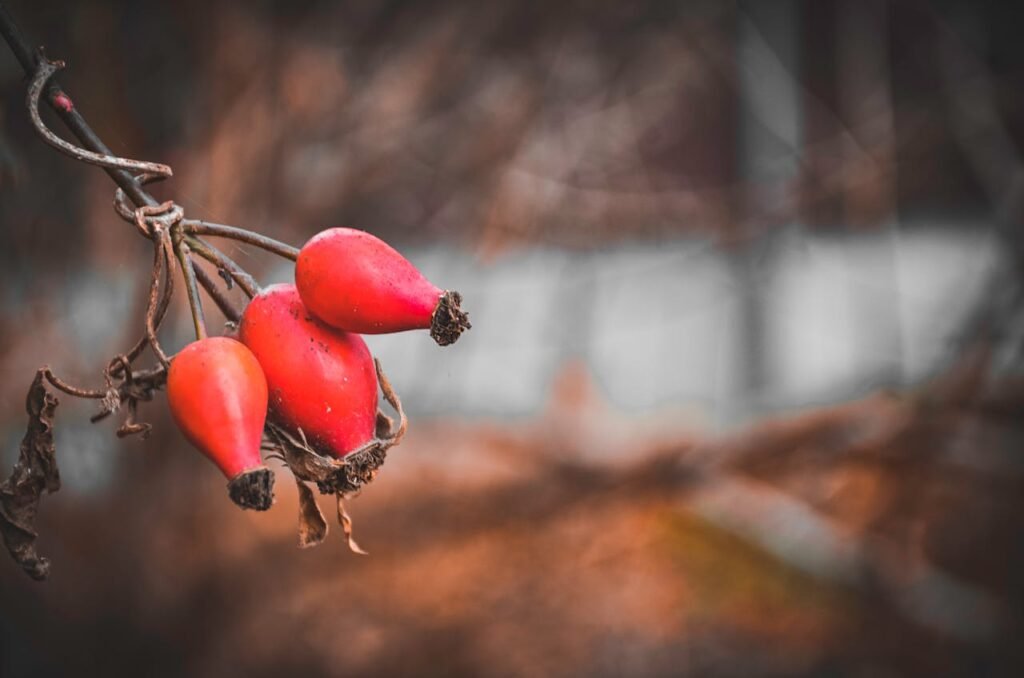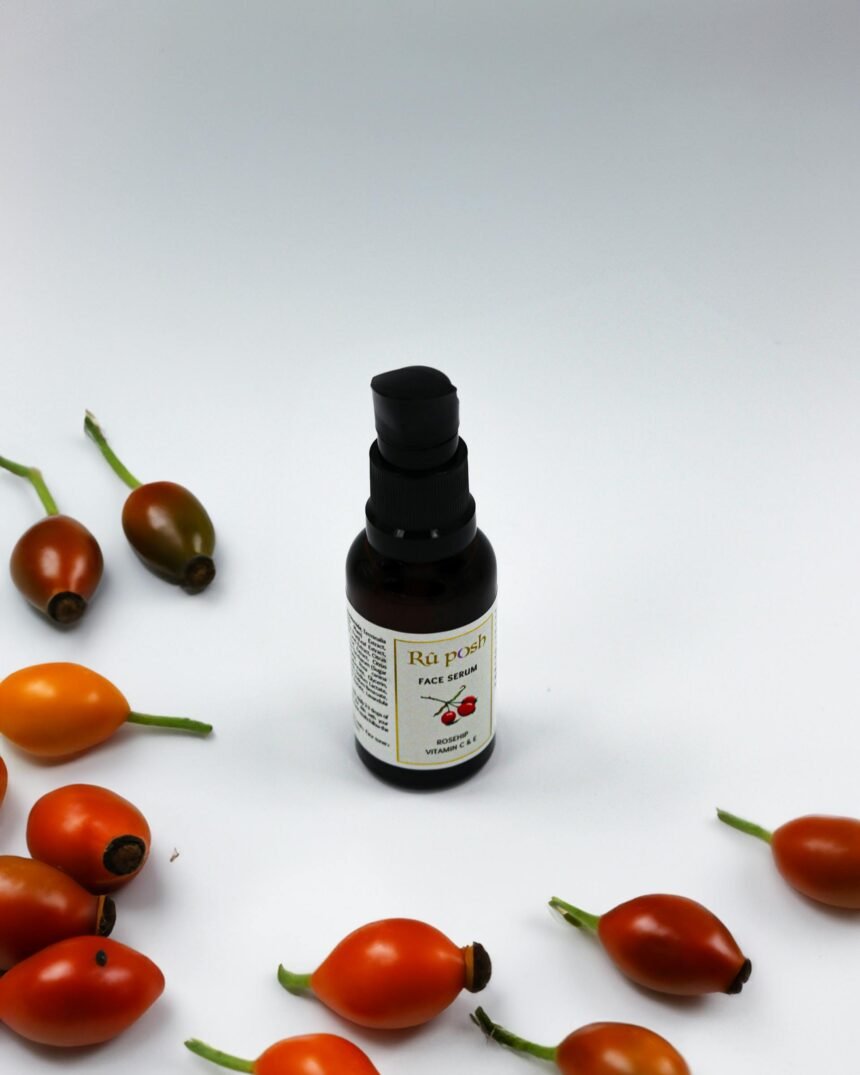Discover the transformative power of rosehip oil for your hair in this comprehensive guide. Learn how this nutrient-rich natural oil can nourish, repair, and enhance your locks, regardless of your hair type.
From promoting growth to taming frizz, we explore the myriad benefits of rosehip oil and provide practical tips for incorporating it into your hair care routine. Understand the science behind its effectiveness, learn application techniques, and get tailored advice for different hair types.
Whether you’re battling damage, seeking more shine, or looking to boost overall hair health, this article reveals why rosehip oil might be the secret ingredient your hair has been craving. Unlock the potential of this versatile oil and embark on your journey to achieving the luscious, shiny locks you’ve always dreamed of.
I. Introduction: Discovering the Magic of Rosehip Oil for Hair
In the quest for beautiful, healthy hair, many of us have tried countless products and treatments. But what if the secret to luscious, shiny locks was hiding in a simple, natural oil? Enter rosehip oil for hair – a game-changer in the world of hair care. This powerful, nutrient-rich oil has been gaining popularity for its remarkable benefits, and it’s time to uncover why it might be the missing piece in your hair care routine.
Rosehip oil, derived from the seeds of wild rose bushes, has been used for centuries in skincare for its nourishing and rejuvenating properties. Now, its benefits are being harnessed for hair care, offering a natural solution to common hair woes. From promoting growth to adding shine and reducing frizz, rosehip oil for hair is proving to be a versatile and effective treatment.
In this comprehensive guide, we’ll explore the many ways rosehip oil can transform your hair. We’ll delve into its unique composition, the science behind its effectiveness, and practical tips for incorporating it into your hair care regimen. Whether you’re dealing with dry, damaged hair, looking to boost growth, or simply want to enhance your hair’s natural beauty, rosehip oil for hair might be the answer you’ve been searching for.
Get ready to discover how this natural wonder can help you achieve the luscious, shiny locks you’ve always dreamed of. Let’s unlock the secrets of rosehip oil for hair and embark on a journey to healthier, more beautiful tresses.
II. Understanding Rosehip Oil: Composition and Benefits for Hair
To truly appreciate the power of rosehip oil for hair, it’s essential to understand what makes this natural oil so special. Rosehip oil is extracted from the seeds of rose bushes, primarily Rosa canina and Rosa rubiginosa. This process yields a lightweight, amber-coloured oil that’s packed with nutrients beneficial for both skin and hair.
Composition of Rosehip Oil
Rosehip oil for hair is rich in several key components that contribute to its hair-enhancing properties:
- Essential Fatty Acids:
- Omega-3 (linolenic acid)
- Omega-6 (linoleic acid)
- Omega-9 (oleic acid)
- Vitamins:
- Vitamin A (retinol)
- Vitamin C
- Vitamin E
- Antioxidants:
- Lycopene
- Beta-carotene
- Minerals:
- Iron
- Magnesium
Benefits of Rosehip Oil for Hair
The unique composition of rosehip oil translates into numerous benefits for your hair:
- Moisturisation: The essential fatty acids in rosehip oil help to deeply moisturise the hair shaft, reducing dryness and brittleness.
- Scalp Health: Vitamin A and C promote a healthy scalp environment, which is crucial for hair growth and overall hair health.
- Strength and Elasticity: The proteins and vitamins in rosehip oil can improve hair strength and elasticity, reducing breakage and split ends.
- Shine Enhancement: The lightweight nature of the oil adds a natural shine to the hair without weighing it down.
- Frizz Control: By moisturising the hair shaft, rosehip oil helps to smooth the cuticle and reduce frizz.
- Protection from Environmental Damage: The antioxidants in rosehip oil protect hair from free radical damage caused by UV rays and pollution.
- Potential Growth Stimulation: While more research is needed, some studies suggest that the nutrients in rosehip oil may stimulate hair follicles and promote growth.
Understanding the composition and benefits of rosehip oil for hair is the first step in harnessing its power for your own locks. As we delve deeper into this guide, we’ll explore how to effectively use rosehip oil to address specific hair concerns and achieve the luscious, shiny hair you desire.
By incorporating rosehip oil into your hair care routine, you’re not just adding another product – you’re introducing a powerhouse of natural nutrients that can transform your hair from the inside out. Whether you’re looking to boost moisture, enhance shine, or improve overall hair health, rosehip oil for hair offers a versatile and effective solution.

III. How to Use Rosehip Oil for Hair: Application Methods and Tips
Now that we understand the benefits of rosehip oil for hair, let’s explore the various ways to incorporate this natural wonder into your hair care routine. The versatility of rosehip oil allows for multiple application methods, each targeting different hair needs and preferences.
1. Direct Application to Scalp and Hair
One of the simplest ways to use rosehip oil for hair is to apply it directly:
- Start with clean, damp hair
- Warm a few drops of rosehip oil between your palms
- Gently massage the oil into your scalp using circular motions
- Work the remaining oil through the lengths of your hair, focusing on the ends
- Leave on for at least 30 minutes or overnight for deeper penetration
- Wash out with a gentle shampoo
Tip: For an intensive treatment, wrap your hair in a warm towel or shower cap to enhance absorption.
2. As a Leave-In Treatment
Rosehip oil can be used as a leave-in treatment for daily nourishment:
- Apply a small amount of oil to the ends of damp or dry hair
- Focus on areas prone to dryness or damage
- Style as usual
Caution: Start with a small amount to avoid greasy-looking hair, especially if you have fine or oily hair types.
3. Mixed with Your Regular Conditioner
Boost your conditioner’s moisturising power with rosehip oil:
- Add a few drops of rosehip oil to your regular conditioner
- Mix well and apply to your hair as usual
- Leave on for 3-5 minutes before rinsing
4. As Part of a Hair Mask
Create a nourishing hair mask using rosehip oil:
- Mix 2 tablespoons of rosehip oil with 1 tablespoon of honey and 1 egg yolk
- Apply the mixture to your hair and scalp
- Leave on for 30 minutes before washing out
5. Pre-Shampoo Treatment
Use rosehip oil as a pre-shampoo treatment to protect hair during washing:
- Apply rosehip oil to dry hair, focusing on the ends
- Leave on for 15-30 minutes before shampooing
- Wash and condition as usual
6. Frizz Control and Styling
Tame frizz and add shine with a small amount of rosehip oil:
- Rub a drop or two of oil between your palms
- Smooth over dry hair, focusing on frizzy areas and ends
- Use sparingly to avoid a greasy appearance
Tips for Using Rosehip Oil for Hair
- Start with a small amount and increase as needed
- Always perform a patch test before full application to check for any allergic reactions
- Use organic, cold-pressed rosehip oil for maximum benefits
- Store rosehip oil in a cool, dark place to preserve its properties
- Combine with other natural oils like argan or jojoba for enhanced benefits
By incorporating these application methods and tips into your hair care routine, you can fully harness the power of rosehip oil for hair. Whether you’re looking for deep nourishment, frizz control, or a boost in shine, there’s a way to use rosehip oil that suits your needs.
Remember, consistency is key when using natural treatments like rosehip oil for hair. Regular use will yield the best results, helping you achieve the luscious, shiny locks you’ve always wanted. Experiment with different methods to find what works best for your hair type and concerns, and enjoy the journey to healthier, more beautiful hair with rosehip oil.
IV. Rosehip Oil for Hair Growth: Stimulating Luscious Locks
One of the most exciting potential benefits of rosehip oil for hair is its ability to promote hair growth. While more research is needed to fully understand its effects, many users report significant improvements in hair growth and thickness after incorporating rosehip oil into their hair care routine. Let’s explore how rosehip oil may contribute to hair growth and how you can use it to potentially stimulate luscious locks.
How Rosehip Oil May Promote Hair Growth
- Scalp Health:
- Rosehip oil’s anti-inflammatory properties can help soothe an irritated scalp
- A healthy scalp environment is crucial for optimal hair growth
- Nutrient Delivery:
- The oil’s composition allows it to penetrate the hair follicles
- Essential fatty acids and vitamins nourish the follicles from within
- Improved Circulation:
- Massaging rosehip oil into the scalp can boost blood flow
- Enhanced circulation may stimulate hair follicles and promote growth
- Strengthening Existing Hair:
- By reducing breakage, rosehip oil allows hair to grow longer and appear fuller
Using Rosehip Oil for Hair Growth
To potentially boost hair growth with rosehip oil, try the following methods:
- Scalp Massage:
- Warm 2-3 drops of rosehip oil between your palms
- Gently massage into your scalp using circular motions
- Focus on areas where you’d like to see more growth
- Leave on overnight and wash out in the morning
- Repeat 2-3 times per week
- Growth-Boosting Hair Mask:
- Mix 1 tablespoon rosehip oil, 1 tablespoon castor oil, and 3 drops peppermint essential oil
- Apply to scalp and hair, focusing on the roots
- Massage gently for 5-10 minutes
- Leave on for 30 minutes to an hour before washing out
- Use weekly for best results
- Daily Scalp Serum:
- In a small bottle, mix 2 tablespoons rosehip oil with 10 drops each of lavender and rosemary essential oils
- Apply a few drops to your scalp daily, massaging gently
- No need to wash out – style as usual
Tips for Maximising Hair Growth with Rosehip Oil
- Be consistent: Regular application is key for seeing results
- Combine with a balanced diet rich in hair-healthy nutrients
- Stay hydrated to support overall hair health
- Avoid harsh chemical treatments that can damage hair and impede growth
- Be patient – hair growth takes time, and results may vary
While rosehip oil for hair growth shows promise, it’s important to have realistic expectations. Hair growth is influenced by various factors, including genetics, overall health, and lifestyle. Rosehip oil can be a valuable tool in your hair growth journey, but it’s not a miracle solution.
Incorporating rosehip oil into your hair care routine for growth can be an enjoyable and potentially beneficial process. The nourishing properties of the oil will improve your hair’s overall health, which in turn may lead to fuller, longer locks. Even if you don’t see dramatic growth, you’re likely to notice improvements in hair texture, shine, and manageability.
Remember, everyone’s hair is unique, and what works for one person may not work for another. If you’re experiencing significant hair loss or have concerns about your hair growth, it’s always best to consult with a healthcare professional or trichologist for personalised advice.
By using rosehip oil for hair growth, you’re taking a natural, nurturing approach to achieving the luscious locks you desire. Embrace the process, enjoy the benefits for your overall hair health, and look forward to the potential of fuller, more vibrant hair.

V. Rosehip Oil for Hair Repair: Healing Damaged Tresses
When it comes to repairing damaged hair, rosehip oil for hair stands out as a powerful natural remedy. Whether your locks have been compromised by heat styling, chemical treatments, or environmental factors, rosehip oil can help restore health and vitality to your tresses. Let’s explore how this wonder oil can be used to heal and rejuvenate damaged hair.
Understanding Hair Damage
Before we delve into repair methods, it’s important to understand what causes hair damage:
- Heat Styling: Excessive use of flat irons, curling wands, and blow dryers
- Chemical Treatments: Bleaching, perming, and harsh dyes
- Environmental Factors: Sun exposure, pollution, and hard water
- Physical Stress: Tight hairstyles, rough brushing, and towel drying
- Nutritional Deficiencies: Lack of essential vitamins and minerals
How Rosehip Oil Helps Repair Damaged Hair
Rosehip oil for hair is particularly effective in addressing damage due to its unique composition:
- Essential Fatty Acids: Help to moisturise and strengthen the hair shaft
- Vitamin A: Promotes sebum production, which naturally conditions the hair
- Vitamin C: Aids in collagen production, essential for hair structure
- Vitamin E: Protects hair from oxidative stress and improves scalp circulation
- Antioxidants: Combat free radical damage and protect hair from further harm
Rosehip Oil Treatments for Damaged Hair
- Intensive Overnight Repair Mask:
- Mix 2 tablespoons rosehip oil with 1 tablespoon honey and 1 egg yolk
- Apply to damp hair, focusing on damaged areas
- Cover with a shower cap and leave overnight
- Wash out in the morning with a gentle shampoo
- Use weekly for severe damage, or bi-weekly for maintenance
- Split End Sealer:
- Warm a few drops of rosehip oil between your palms
- Gently apply to the ends of your hair, focusing on split ends
- Use daily on dry or damp hair
- No need to rinse out
- Pre-Shampoo Protection:
- Apply rosehip oil to dry hair 30 minutes before washing
- Focus on mid-lengths to ends
- Shampoo and condition as usual
- This helps protect hair from the drying effects of shampoo
- Leave-In Conditioner Boost:
- Add 2-3 drops of rosehip oil to your regular leave-in conditioner
- Apply as usual, focusing on damaged areas
- Style as normal
Tips for Maximising Hair Repair with Rosehip Oil
- Be consistent with treatments for best results
- Avoid heat styling while repairing damaged hair
- Use a silk or satin pillowcase to reduce friction while sleeping
- Trim your hair regularly to remove split ends
- Combine rosehip oil treatments with a protein-rich diet for internal support
Preventing Future Damage
While using rosehip oil for hair repair, it’s crucial to prevent further damage:
- Limit heat styling and always use a heat protectant
- Avoid tight hairstyles that can cause breakage
- Use a wide-toothed comb to detangle wet hair gently
- Protect your hair from sun damage with hats or UV-protective products
- Avoid harsh chemical treatments during the repair process
Incorporating rosehip oil into your hair care routine can significantly improve the health and appearance of damaged hair. Its nourishing properties work to strengthen, moisturise, and protect your locks, helping to reverse the signs of damage and prevent future issues.
Remember, healing damaged hair is a process that requires patience and consistency. While rosehip oil can work wonders, it’s not an overnight solution. Combine regular treatments with gentle hair care practices and a healthy lifestyle for the best results.
By using rosehip oil for hair repair, you’re choosing a natural, effective way to restore your tresses to their former glory. Embrace the healing power of this remarkable oil and look forward to healthier, more resilient hair. With time and care, those damaged locks will transform into the luscious, shiny tresses you’ve been dreaming of.
VI. Rosehip Oil for Different Hair Types: Tailoring Your Treatment
One of the great things about rosehip oil for hair is its versatility – it can benefit a wide range of hair types and textures. However, the way you use it may vary depending on your specific hair needs. In this section, we’ll explore how to tailor your rosehip oil treatment for different hair types, ensuring that everyone can enjoy the benefits of this natural wonder.
1. Fine Hair
Tips:
- Always apply to damp hair for better absorption and distribution
- Consider using rosehip oil once a week rather than daily
- Avoid applying near the roots to prevent a greasy appearance
2. Thick Hair
Thick hair often needs more moisture and can handle larger amounts of oil:
- Use generously: 3-5 drops for shoulder-length hair, more for longer hair
- Deep conditioning: Mix with your regular conditioner for added nourishment
- Overnight treatment: Apply liberally and wrap hair in a silk scarf overnight
- Frizz control: Use as a styling product to tame flyaways and add shine
Tips:
- Focus on mid-lengths to ends where thick hair tends to be drier
- Combine with other oils like coconut or argan for an extra moisture boost
3. Curly Hair
Curly hair often struggles with dryness and frizz, making it an ideal candidate for rosehip oil:
- Moisture sealing: Apply to damp hair to lock in hydration
- Curl definition: Use as a styling product to enhance and define curls
- Scalp treatment: Massage into the scalp to combat dryness and flaking
- Mix with styling products: Add a few drops to your favourite curl cream or gel
Tips:
- Apply using the ‘praying hands’ method for even distribution
- Refresh curls between washes with a rosehip oil and water spray
4. Oily Hair
While it may seem counterintuitive, rosehip oil can benefit oily hair by balancing sebum production:
- Scalp treatment: Apply directly to the scalp once a week to regulate oil production
- Ends only: Use on the ends of hair where oil is needed most
- Dilute with water: Mix a drop of oil with water in a spray bottle for a light mist
- Pre-shampoo treatment: Apply 30 minutes before washing to protect hair from harsh cleansers
Tips:
- Use less frequently, starting with once a week and adjusting as needed
- Always follow with a clarifying shampoo to remove any excess oil
5. Dry or Damaged Hair
Dry or damaged hair can benefit greatly from the nourishing properties of rosehip oil:
- Intensive treatment: Apply generously from roots to ends and leave overnight
- Mix with deep conditioner: Boost your regular treatments with added rosehip oil
- Daily moisturiser: Use a small amount on dry ends daily
- Heat protection: Apply before heat styling to protect hair from damage
Tips:
- Combine with other reparative ingredients like honey or avocado for deep treatments
- Use consistently for best results in improving hair health
6. Colour-Treated Hair
Rosehip oil can help maintain colour vibrancy and combat the drying effects of hair dye:
- Colour protection: Apply before swimming or sun exposure to prevent fading
- Hydration boost: Use as a leave-in treatment to combat dryness from colouring
- Shine enhancer: Apply a small amount to dry hair for added lustre
- Pre-colour treatment: Use as a protective layer before applying hair dye
Tips:
- Look for cold-pressed, organic rosehip oil for maximum benefits
- Avoid using immediately after colouring; wait at least 48 hours
By tailoring your use of rosehip oil to your specific hair type, you can maximise its benefits and achieve the best results. Remember to start with small amounts and adjust as needed – it’s always easier to add more than to remove excess oil.
Experimenting with different application methods and frequencies will help you find the perfect rosehip oil routine for your hair. Whether you have fine, thick, curly, oily, dry, damaged, or colour-treated hair, there’s a way to incorporate this versatile oil into your hair care regimen.
As you explore the benefits of rosehip oil for your hair type, pay attention to how your hair responds. You may find that your hair’s needs change with the seasons or as its health improves. Be flexible and willing to adjust your routine as necessary to continue reaping the benefits of this natural hair care wonder.
With consistent use and proper application, rosehip oil can help transform your hair, regardless of its type or condition. Embrace the versatility of this natural oil and enjoy the journey to healthier, more beautiful hair.

VII. Potential Side Effects and Precautions
While rosehip oil for hair is generally safe and beneficial for most people, it’s important to be aware of potential side effects and take necessary precautions. As with any new product, it’s always best to approach with caution and be mindful of how your hair and scalp react.
Potential Side Effects
- Allergic Reactions:
- Some individuals may be allergic to rosehip oil
- Symptoms can include itching, redness, or rash on the scalp or skin
- Scalp Irritation:
- In rare cases, rosehip oil may cause scalp irritation, especially if used in large quantities
- Greasy Appearance:
- Overuse can lead to a greasy or oily appearance, particularly for those with fine or oily hair
- Acne or Breakouts:
- If applied near the hairline, some people may experience acne or breakouts
- Sun Sensitivity:
- Rosehip oil can increase skin sensitivity to UV rays, which may affect the scalp if exposed to sunlight
Precautions and Best Practices
- Patch Test:
- Always perform a patch test before full application
- Apply a small amount of oil to your inner wrist or behind your ear
- Wait 24 hours to check for any adverse reactions
- Start Small:
- Begin with a small amount of oil and gradually increase as needed
- This helps prevent overuse and allows you to gauge your hair’s response
- Quality Matters:
- Choose high-quality, cold-pressed, organic rosehip oil
- Avoid oils with added fragrances or preservatives
- Storage:
- Store rosehip oil in a cool, dark place to prevent rancidity
- Consider refrigeration to extend shelf life
- Pregnancy and Breastfeeding:
- Consult with a healthcare provider before using rosehip oil if pregnant or breastfeeding
- Medication Interactions:
- If you’re taking any medications, especially blood thinners, consult your doctor before using rosehip oil
- Sun Protection:
- If using rosehip oil during the day, ensure your scalp is protected from sun exposure
- Dilution:
- For sensitive scalps, consider diluting rosehip oil with a carrier oil like jojoba or coconut oil
- Frequency of Use:
- Pay attention to how often your hair needs treatment
- Overuse can lead to build-up or greasy appearance
- Discontinue Use If:
- You experience any adverse reactions
- Your hair becomes overly greasy or limp
By being aware of these potential side effects and following these precautions, you can safely enjoy the benefits of rosehip oil for your hair. Remember, everyone’s hair and scalp are different, so what works for one person may not work for another. Listen to your body and adjust your use of rosehip oil accordingly.
If you have any pre-existing scalp conditions or concerns, it’s always best to consult with a dermatologist or trichologist before incorporating rosehip oil into your hair care routine. They can provide personalised advice based on your specific needs and hair type.
With proper use and attention to these precautions, rosehip oil can be a safe and effective addition to your hair care regimen, helping you achieve the luscious, shiny locks you desire.
VIII. Conclusion: Embracing Rosehip Oil for Luscious, Shiny Locks
As we conclude our exploration of rosehip oil for hair, it’s clear that this natural wonder offers a multitude of benefits for those seeking luscious, shiny locks. From its nourishing properties to its versatility across different hair types, rosehip oil has proven itself to be a valuable addition to any hair care routine.
Throughout this guide, we’ve uncovered the secrets of rosehip oil’s composition, its numerous benefits for hair health, and the various ways it can be incorporated into your hair care regimen. We’ve explored its potential for promoting hair growth, repairing damage, and addressing the specific needs of different hair types. We’ve also discussed important precautions to ensure safe and effective use.
Key takeaways from our journey into the world of rosehip oil for hair include:
- Nutrient-Rich Composition: Packed with essential fatty acids, vitamins, and antioxidants, rosehip oil provides comprehensive nourishment for your hair.
- Versatility: Whether you have fine, thick, curly, or straight hair, there’s a way to incorporate rosehip oil into your routine.
- Natural Solution: As a natural product, rosehip oil offers an alternative to synthetic hair treatments, aligning with the growing trend towards clean beauty.
- Multi-Purpose Use: From deep conditioning treatments to frizz control and scalp care, rosehip oil serves multiple purposes in hair care.
- Potential for Hair Growth: While more research is needed, many users report improved hair growth and thickness with regular use of rosehip oil.
- Damage Repair: The nourishing properties of rosehip oil make it an excellent choice for repairing and preventing hair damage.
- Ease of Use: With various application methods available, it’s easy to find a way to incorporate rosehip oil into your existing hair care routine.
As you embark on your journey with rosehip oil for hair, remember that consistency is key. Like any natural treatment, it may take time to see significant results. Be patient, and enjoy the process of nurturing your hair with this luxurious oil.
We encourage you to experiment with different application methods and find what works best for your unique hair type and concerns. Whether you’re using it as a pre-shampoo treatment, a leave-in conditioner, or a deep conditioning mask, rosehip oil has the potential to transform your hair care routine.
As always, listen to your hair and scalp. If you experience any adverse reactions, discontinue use and consult a professional. Hair care is a personal journey, and what works for one person may not work for another.
In conclusion, rosehip oil for hair offers a natural, effective way to achieve the luscious, shiny locks you’ve always desired. By harnessing the power of this nutrient-rich oil, you’re not just improving the appearance of your hair – you’re nourishing it from the inside out. Embrace the beauty of rosehip oil and enjoy the journey to healthier, more vibrant hair.
Here’s to your hair health and the luscious, shiny locks that await you with the magic of rosehip oil!
IX. FAQs About Rosehip Oil for Hair
- Q: How often should I use rosehip oil on my hair?
A: The frequency depends on your hair type. For normal to dry hair, 2-3 times a week is usually sufficient. For oily hair, once a week may be enough. Adjust based on your hair’s response. - Q: Can rosehip oil help with hair loss?
A: While not a cure for hair loss, rosehip oil may help create a healthier scalp environment conducive to hair growth. Its nutrients can strengthen existing hair, potentially reducing breakage. - Q: Is rosehip oil suitable for all hair types?
A: Yes, rosehip oil can benefit all hair types. However, the application method and amount may vary depending on whether your hair is fine, thick, curly, or straight. - Q: Can I leave rosehip oil in my hair overnight?
A: Yes, leaving rosehip oil in overnight can provide deep nourishment. Just be sure to protect your pillowcase and rinse thoroughly in the morning. - Q: Will rosehip oil make my hair greasy?
A: If used in appropriate amounts, it shouldn’t. Start with a small amount and increase gradually. Those with fine or oily hair should use less and focus on the ends. - Q: Can I use rosehip oil on colour-treated hair?
A: Yes, rosehip oil is generally safe for colour-treated hair. It can help maintain colour vibrancy and combat dryness often associated with hair dye. - Q: How long does it take to see results from using rosehip oil on hair?
A: Results can vary, but many people notice improvements in shine and texture within a few weeks of consistent use. More significant changes may take 1-3 months. - Q: Can rosehip oil replace my regular conditioner?
A: While rosehip oil is deeply nourishing, it’s best used in conjunction with your regular conditioner rather than as a replacement. - Q: Is it safe to use rosehip oil on the scalp?
A: Yes, rosehip oil can be safely applied to the scalp. It may help with dryness and promote a healthy scalp environment. However, those with oily scalps should use caution. - Q: Can I mix rosehip oil with other hair oils?
A: Absolutely! Rosehip oil pairs well with other oils like argan, jojoba, or coconut oil. Mixing can provide additional benefits and allow you to customise your hair treatment.
X. Table: Rosehip Oil Application Guide for Different Hair Types
| Hair Type | Recommended Application | Frequency | Amount | Tips |
|---|---|---|---|---|
| Fine Hair | Ends only or pre-shampoo treatment | 1-2 times per week | 1-2 drops | Avoid roots, focus on ends |
| Thick Hair | All over, including scalp | 2-3 times per week | 3-5 drops | Can be used as leave-in treatment |
| Curly Hair | Scrunch into damp hair | 2-3 times per week | 2-4 drops | Great for defining curls |
| Oily Hair | Ends only or scalp treatment | Once a week | 1-2 drops | Use sparingly, focus on problem areas |
| Dry/Damaged Hair | All over, including scalp | 3-4 times per week | 4-6 drops | Can be left overnight for deep treatment |
| Colour-Treated Hair | Mid-lengths to ends | 2-3 times per week | 2-4 drops | Use as heat protectant before styling |
This table provides a quick reference guide for using rosehip oil on different hair types. Remember to adjust the amount and frequency based on your hair’s specific needs and response to the oil.






